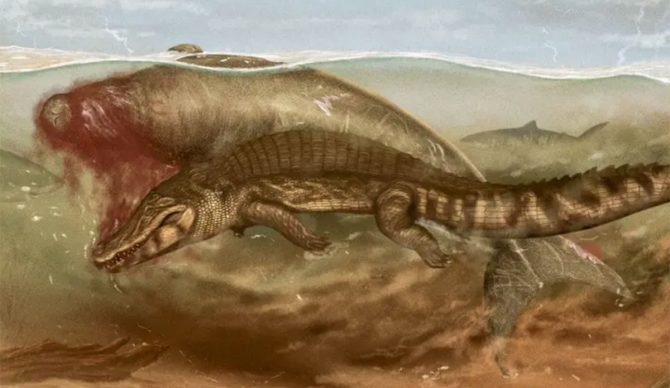
The ancient sea cow did not have a great final day. Image: Jaime Bran Sarmiento//Journal of Vertebrate Paleontology
Sharks have been cruising around in the oceans for somewhere around 450 million years. In that time, they haven’t changed all that much, because when it comes to evolution, you don’t mess with perfection. And between 23 and 12-million years ago, an ancient sea cow found that out firsthand.
The dugong sea cow belonged to a genus called Culebratherium that was hunted to extinction in the 18th century. The fossilized remains of this particular one had a really bad last day — it wasn’t just attacked by a shark, but by a crocodile, as well.
“The gruesome scene has been pieced together from fossils of the poor old sea cow, with bite marks indicating the crocodilian tried to suffocate its prey in a ‘death roll,'” IFLScience wrote. “There was also a shark’s tooth found by its neck and bites along its body, demonstrating that multiple prehistoric predators attended the feast.”
The fossils were found after a farmer in Coro, Venezuela alerted the researchers to a peculiar bunch of rocks on his land about 60 miles away from anywhere anyone had looked before. Once they looked into it, they found something pretty spectacular.
“Our findings constitute one of the few records documenting multiple predators over a single prey,” said lead author Aldo Benites-Palomino from the Department of Paleontology at Zurich. “And as such they provide a glimpse of food-chain networks in this region during the Miocene.”
It’s normal in present day to see a carcass feed a multitude of creatures, from the apex predator and the carrion eaters to birds and tiny little bugs. But evidence of this from thousands of years ago is scant.
“Today, often when we observe a predator in the wild, we find the carcass of prey which demonstrates its function as a food source for other animals too; but fossil records of this are rarer,” Benites-Palomino continued. “We have been unsure as to which animals would have served this purpose as a food source for multiple predators. Our previous research has identified sperm whales scavenged by several shark species, and this new research highlights the importance of sea cows within the food chain.”
When the scene of the sea cow’s death was put together, it was theorized that an ancient crocodilian first caught the sea cow by its snout. Then, like the crocodiles of today, it pulled its prey into its signature death roll.
Sometime after, a tiger shark from the species Galeocerdo aduncus got a hold of it and left teeth in the sea cow’s neck and ribcage. There is also evidence of bite marks on most of the rest of the skeleton. It’s likely that the shark swooped in after the crocodile for a scavenged meal.

